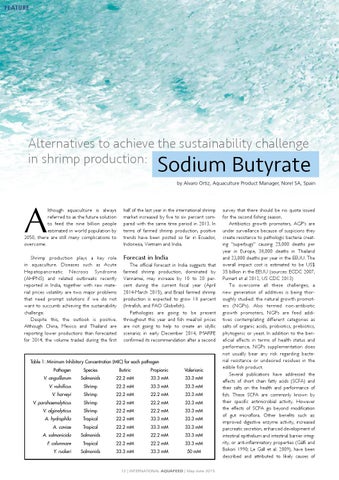FEATURE
Alternatives to achieve the sustainability challenge in shrimp production:
Sodium Butyrate by Alvaro Ortiz, Aquaculture Product Manager, Norel SA, Spain
A
lthough aquaculture is always referred to as the future solution to feed the nine billion people estimated in world population by 2050, there are still many complications to overcome.
half of the last year in the international shrimp market increased by five to six percent compared with the same time period in 2013. In terms of farmed shrimp production, positive trends have been posted so far in Ecuador, Indonesia, Vietnam and India.
Shrimp production plays a key role in aquaculture. Diseases such as Acute Hepatopancreatic Necrosis Syndrome (AHPNS) and related outbreaks recently reported in India, together with raw material prices volatility are two major problems that need prompt solutions if we do not want to succumb achieving the sustainability challenge. Despite this, the outlook is positive. Although China, Mexico and Thailand are reporting lower productions than forecasted for 2014, the volume traded during the first
Forecast in India
The official forecast in India suggests that farmed shrimp production, dominated by Vannamei, may increase by 10 to 20 percent during the current fiscal year (April 2014-March 2015), and Brazil farmed shrimp production is expected to grow 18 percent (Intrafish, and FAO Globefish). Pathologies are going to be present throughout this year and fish meal/oil prices are not going to help to create an idyllic scenario; in early December 2014, IMARPE confirmed its recommendation after a second
Table 1: Minimum Inhibitory Concentration (MIC) for each pathogen Pathogen V. anguillarum
Species
Butiric
Propionic
Valerianic
Salmonids
22.2 mM
33.3 mM
33.3 mM
V. vulnificus
Shrimp
22.2 mM
33.3 mM
33.3 mM
V. harveyi
Shrimp
22.2 mM
22.2 mM
33.3 mM
V. parahaemolyticus
Shrimp
22.2 mM
22.2 mM
33.3 mM
V. alginolyticus
Shrimp
22.2 mM
22.2 mM
33.3 mM
A. hydrophila
Tropical
22.2 mM
33.3 mM
33.3 mM
Tropical
22.2 mM
33.3 mM
33.3 mM
Salmonids
22.2 mM
22.2 mM
33.3 mM
Tropical
22.2 mM
22.2 mM
33.3 mM
Salmonids
33.3 mM
33.3 mM
50 mM
A. caviae A. salmonicida F. columnare Y. ruckeri
12 | INTERNATIONAL AQUAFEED | May-June 2015
survey that there should be no quota issued for the second fishing season. Antibiotics growth promoters, AGP’s are under surveillance because of suspicions they create resistance to pathologic bacteria creating “superbugs” causing 25,000 deaths per year in Europe, 38,000 deaths in Thailand and 23,000 deaths per year in the EEUU. The overall impact cost is estimated to be US$ 35 billion in the EEUU (sources: ECDC 2007, Pumart et al 2012, US CDC 2013) To overcome all these challenges, a new generation of additives is being thoroughly studied: the natural growth promoters (NGPs). Also termed non-antibiotic growth promoters, NGPs are feed additives contemplating different categories as salts of organic acids, probiotics, prebiotics, phytogenic or yeast. In addition to the beneficial effects in terms of health status and performance, NGPs supplementation does not usually bear any risk regarding bacterial resistance or undesired residues in the edible fish product. Several publications have addressed the effects of short chain fatty acids (SCFA) and their salts on the health and performance of fish. These SCFA are commonly known by their specific antimicrobial activity. However the effects of SCFA go beyond modification of gut microflora. Other benefits such as: improved digestive enzyme activity, increased pancreatic secretion, enhanced development of intestinal epithelium and intestinal barrier integrity, or anti-inflammatory properties (Gálfi and Bokori 1990; Le Gall et al. 2009), have been described and attributed to likely causes of
